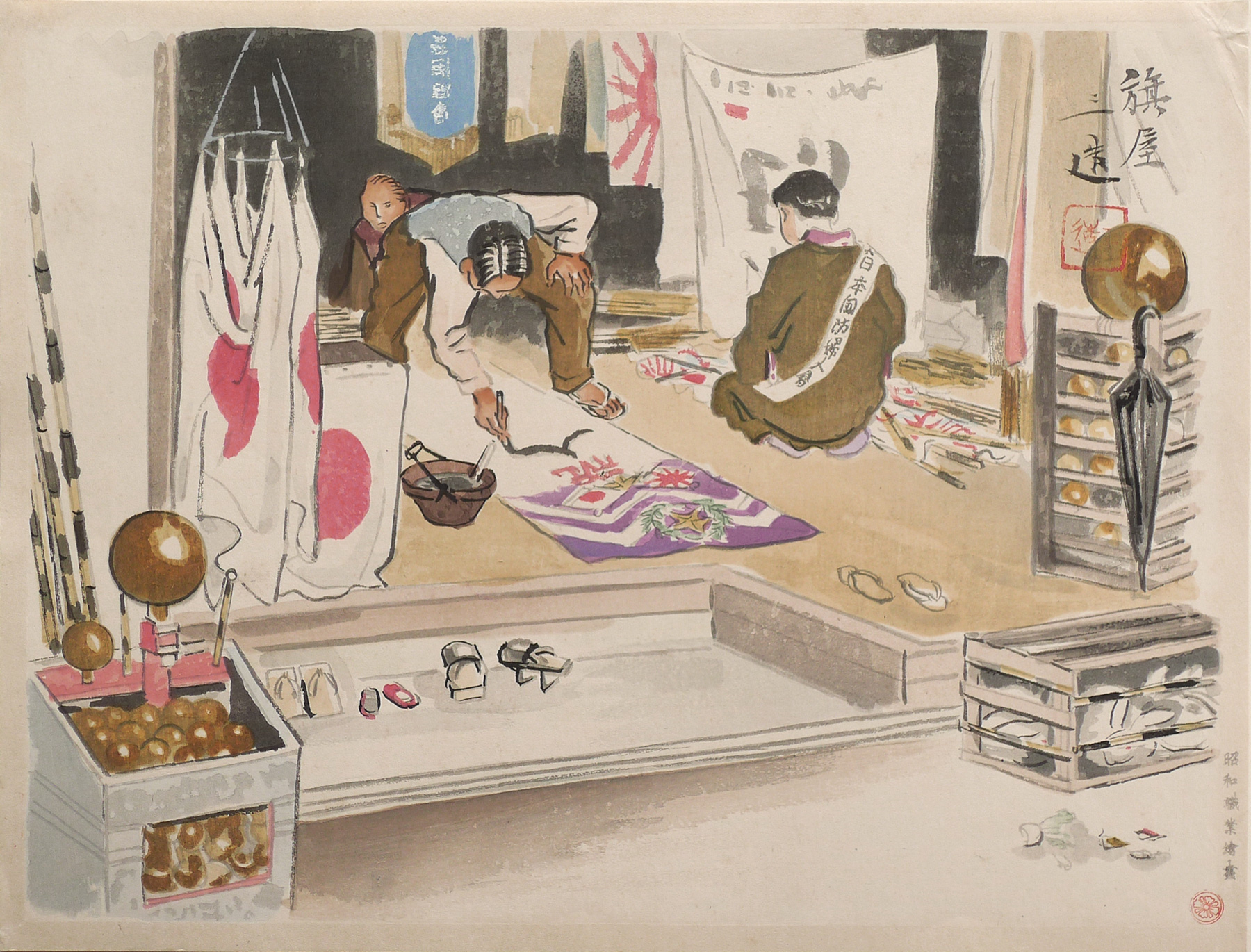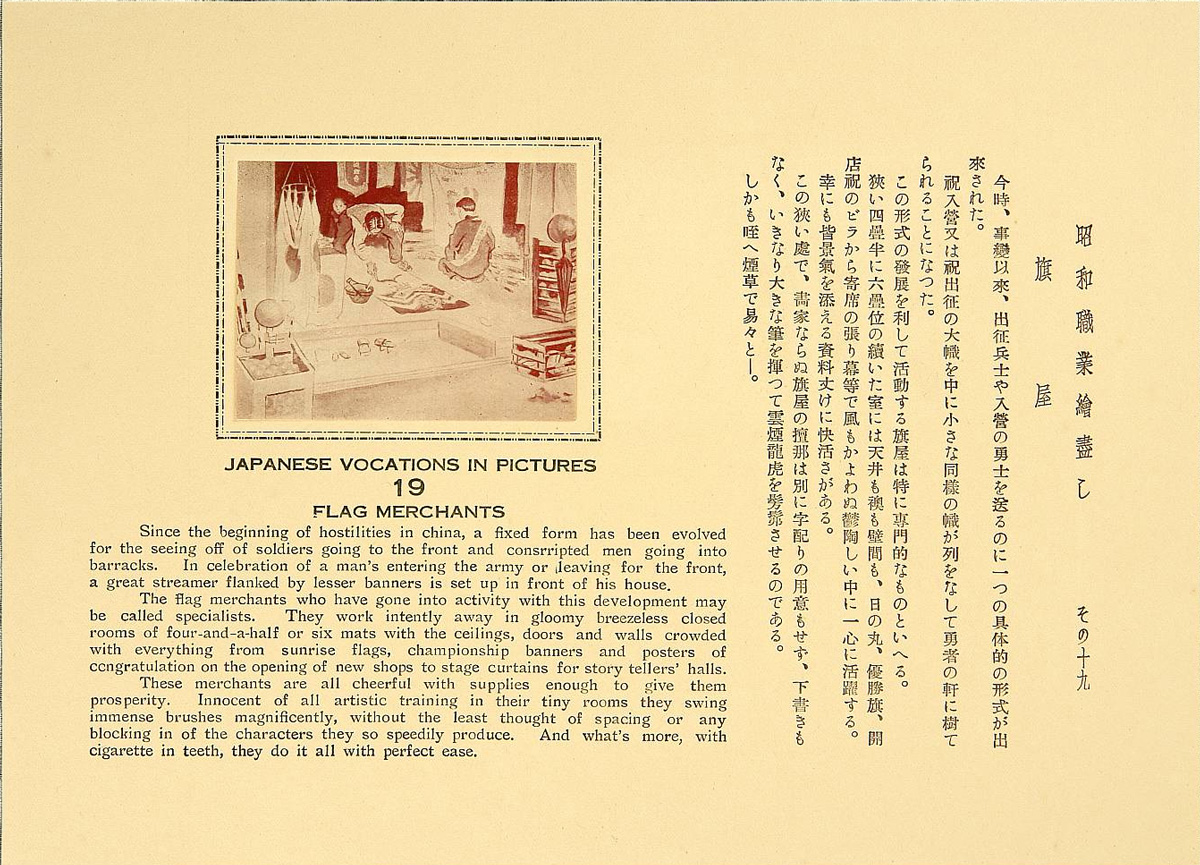About This PrintPicturing an artisan painting a banner, this print titled Flag Merchants was originally issued in May 1940 by Nishinomiya Shoin as the nineteenth print in the series Occupations of Shōwa Japan in Pictures. At least three states of this print exist and the print was not re-issued after the war by Kyoto Hangain, the successor to the publisher Nishinomiya Shoin, which reprinted many prints from the two pre-war series and issued a new twenty-four print third series. This is not surprising, given that the depiction of patriotic sentiment, e.g. Japanese flags, was not a politically correct sentiment after the War.
The major difference between the three states seems to be the positioning of the artist's signature and seal and the use of different artist seals. (See two additional states of this print, below.) This collection's print bears Nishinomiya's circular red publisher's seal and is likely an earlier edition. It appears that this print was not re-issued after the War by Kyoto Hangain, which reprinted many prints from the two pre-War series and issued a new third series of prints. This is not surprising, given that the depiction of patriotic sentiment, e.g. Japanese flags, was not a politically correct sentiment after the War.
note difference in positioning of artist's signature and the used of different artist seals
As described in Memories of Shōwa: Impressions of Working Life by Wada Sanzō, each print was originally released with an explanatory sheet by Wada in Japanese "containing detailed information and personal insights."1 Some of the accompanying commentaries were also translated into English by "Glenn W. Shaw (1881-1961), a writer and teacher who moved to Japan in 1913", as is the below translation.2
JAPANESE VOCATION IN PICTURES 19 FLAG MERCHANTS Since the beginning of hostilities in china [sic], a fixed form has been evolved for the seeing off of soldiers going to the front and consrripted [sic] men going into barracks. In celebration of a man's entering the army or leaving for the front, a great streamer flanked by lesser banners is set up in front of his house.
The flag merchants who have gone into activity with this development may be called specialists. They work intently away in gloomy breezeless closed rooms of four-and-a-half or six mats with ceilings, doors and walls crowded with everything from sunrise flags, championship banners and posters of congratulation on the opening of new shop to stage curtains for story tellers' halls.
These merchants are all cheerful with supplies enough to give them prosperity. Innocent of all artistic training in their tiny rooms they swing immense brushes magnificently without the least thought of spacing or any blocking in of the characters they so speedily produce. And what's more, with cigarette in teeth, they do it all with perfect ease.
|
insert accompanying original issue (not part of this collection) click on image to enlarge 1 Memories of Shōwa: Impressions of Working Life by Wada Sanzō, Maureen de Vries and Daphne van der Molen, Nihon no hanga, 2021, p. 14. 2 ibid. A Critical View of the Series Source: Light in Darkness: Women in Japanese Prints of Early Shōwa (1926-1945), Kendall H. Brown, et. al., Fisher Gallery, University of Southern California, 1996, p. 12. In the introduction to the catalog of the exhibition Light in Darkness: Women in Japanese Prints of Early Shōwa (1926-1945), Dr. Kendall H. Brown, states: The majority of these wartime prints show male occupations but give little sense of Japan’s military involvements or even Japan’s status as a highly industrialized country. (These characteristics may account for the popularity of the series when reissued after the war.) Only a few prints show military men, and, not surprisingly, they display soldiers in non-military activities such as relaxing in their bunks or studying.
|
About the Series "Occupations of Shōwa Japan in Pictures"
Sources: website of Ross Walker Ohmi Gallery http://www.ohmigallery.com/DB/Artists/Sales/Wada_Sanzo.asp and website of USC Pacific Asian Museum "Exhibition - The Occupations of Shōwa Japan in Pictures: The Woodblock Prints of Wada Sanzō"
Note:
My special thanks to Shinagawa Daiwa, the current owner of Kyoto Hangain, for providing the below information (in a series of emails in July 2014) about Nishinomiya Shoin and Kyoto Hangain, both businesses started by his father Shinagawa Kyoomi. Shinagawa's current website can be accessed at http://www.amy.hi-ho.ne.jp/kyotohangain/ Wada’s major contribution as a woodblock print artist came through his 72 print 3-part series Occupations of Shōwa Japan in Pictures (Shōwa shokugyō e-zukishi), also translated as Occupations of the Shōwa Era in Pictures and Japanese Vocations in Pictures. The three part series was started during the Pacific War (1937-1945) in September 1938, was then interrupted by war shortages in 1943, and was restarted again after the war in January 1954. This series was a labor of love for Wada and he brought together woodblock print printers and carvers in Nishimomiya near Kobe to work on this project.
The war era prints were published by Wada through an old books store, Nishinomiya shoin 西宮書院 run by Shinagawa Kyoomi planned a total of 100 designs, with two prints being issued each month. Wada's designs for the prints were rendered in watercolor and the finished prints beautifully captured the look-and-feel of those original watercolors. The series was an immediate hit, but was suspended after 48 prints (issued in two series) in 1943 due to war shortages. After the war, the series was continued by the same publisher, Shinagawa Kyoomi, who had opened a new business in Kyoto, which he named Kyoto Hangain 京都版画院. (Shingawa's business in Nishinomiya had burned down during WWII.) At first Kyoto Hangain published re-prints of the earlier prints, but they went on to publish a third series of 24 prints, working closely with Wada, titled Continuing Occupations of Shōwa Japan in Pictures between November 1954 and September 1956.1 The post-war prints were popular with the Occupation's "deep-pocketed" military and civilian personnel and the series was "featured in an article of the Tokyo edition of the United States military newspaper Stars and Stripes."2 Shinagawa also published a six print portfolio in the 1950s titled Japanese Life and Customs, consisting of six of the prints from the earlier two series in a reduced chuban size, which is also part of this collection. Occupations of Shōwa Japan in Pictures has been praised for showing “the complexity of Shōwa society…. capture[ing] the pulse of Japanese life during the tumultuous decades of the 1930s, 1940s and 1950s”3 and condemned as providing a “visual message of subtle or blatant propaganda in support of government-sponsored ideas.”4 It is interesting to see how the commentary, written by the artist, that accompanied each print in the pre-war releases was softened for the post-war re-issues by Kyoto Hangain. All references to soldiers being away from home (as Japanese armies were marching through Asia when the series was originally released) or references to Imperial Japan have been stripped away and the commentary becomes innocent, folk-like and appealing to the post-war occupying forces. (For example, see the prints Women Weavers and Picture Card Show which provide the artist's original commentary and a full transcript of the English text attached to the folders of the post-war re-issued prints.) 1 Keizaburo Yamaguchi gives the publication dates of the post-War series as January 1954 through autumn 1958. (Ukiyo-e Art 16, 1967): 39-42. 2 "Out of the Dark Valley: Japanese Woodblock Prints and War, 1937-1945," Kendall H. Brown,p. 82 appearing in Impressions, The Journal of the Ukiyo-e Society of America, Inc., Number 23, 2001.3 Pacific Asia Museum website http://www.pacificasiamuseum.org/_on_view/exhibitions/2004/occshowa.aspx 4 Light in Darkness: Women in Japanese Prints of Early Shōwa (1926-1945), Kendall H. Brown, et. al., Fisher Gallery, University of Southern California, 1996, p. 18.
Print Details | IHL Catalog | #1021 | | Title/Description | 旗屋 [hataya] - Flag Merchants [number 19] | | Series | Occupations of Shōwa Japan in Pictures, Series 1 (also seen translated as "Compendium of Occupations in the Shōwa Era" and "Japanese Vocations in Pictures")
Shōwa shokugyō e-zukushi 昭和職業繪盡 (also seen written as 昭和職業絵尽し and
昭和職業繪盡し), daiishū (第一輯) | Artist
| Wada Sanzō (1883-1967)
| Signature
| 三造 Sanzō | | Seal | Sanzō | | Publication Date | May 1940
| | Publisher |  Nishinomiya Shoin 西宮 書院 Nishinomiya Shoin 西宮 書院 | | Edition | first edition | | Impression | excellent | | Colors | excellent | | Condition | good - light overall toning; slight tear and thinning upper right corner caused by removal from original folio.
| | Genre | shin hanga
| | Miscellaneous | originally released by Nishinomiya Shoin as print number 19 in series 1 | | Format | dai-oban
| | H x W Paper | 11 1/2 x 15 1/8 in. (29.2 x 38.4 cm)
| | H x W Image | 10 3/4 x 14 3/8 in. (27.3 x 36.5 cm) | | Collections This Print | Himeji City Museum of Art Ⅲ-183-19 (dated "1939~1940年"); British Museum 2003,0816,0.3 | | Reference Literature | Light in Darkness: Women in Japanese Prints of Early Shōwa (1926-1945), Kendall H. Brown, et. al., Fisher Gallery, University of Southern California, 1996, p. 19-20, cat. 16; Memories of Shōwa: Impressions of Working Life by Wada Sanzō, Maureen de Vries and Daphne van der Molen, Nihon no hanga, 2021 |
last revision:8/9/2021 12/5/2018 |

 Nishinomiya Shoin 西宮 書院
Nishinomiya Shoin 西宮 書院




